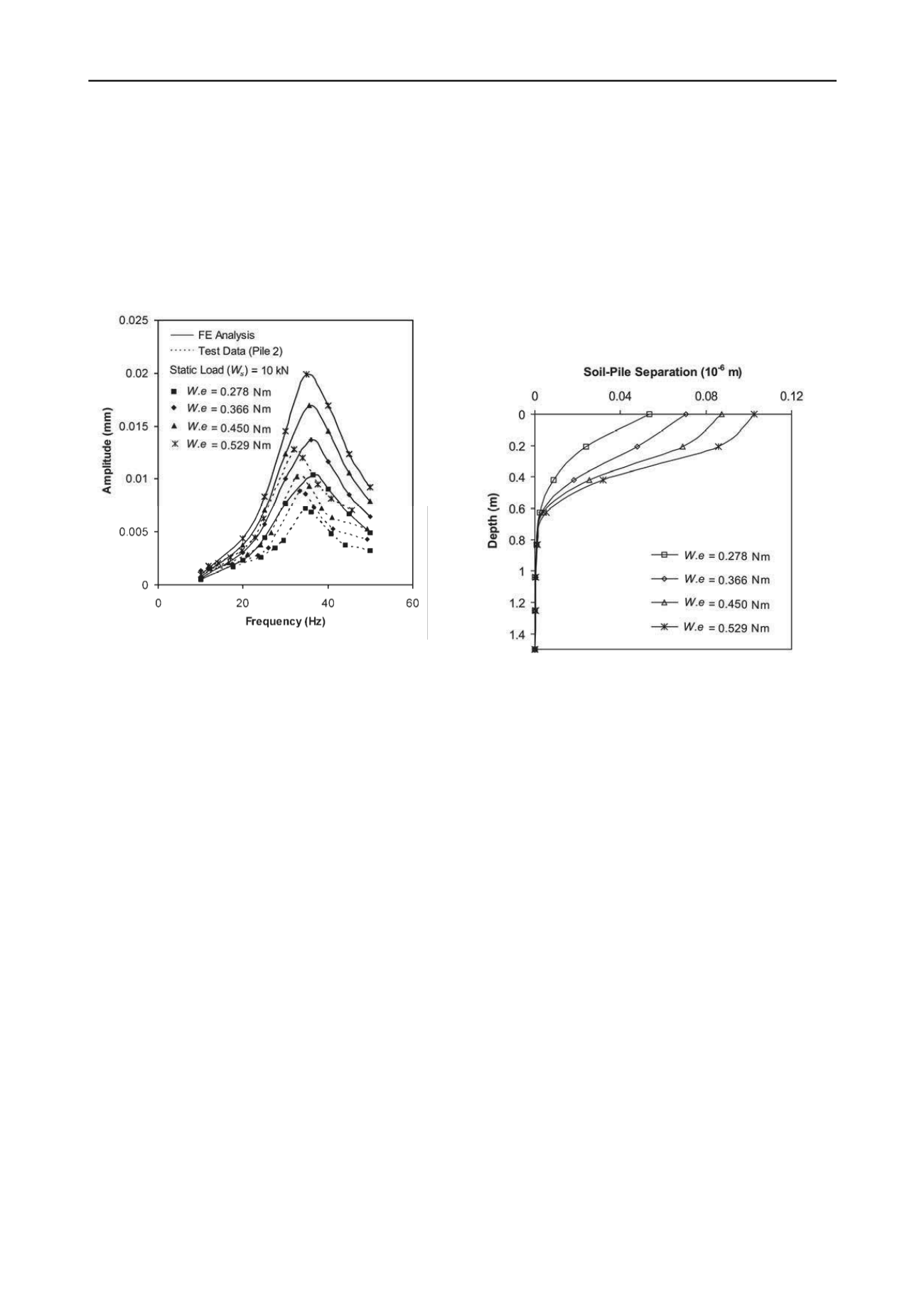
2694
Proceedings of the 18
th
International Conference on Soil Mechanics and Geotechnical Engineering, Paris 2013
in shear modulus during vibration. The negligible difference in
resonant frequencies with the test results are due to the average
soil properties and stratifications considered in the FE analysis.
Though there is a significance difference in amplitude values
but it is understandable that it can be optimize by implementing
precise represented field damping values of soil. In spite of
nonlinearity, the FE model can also able to describe vibration
theories by showing the pattern of reducing resonant frequency
and amplitude values with the increase of static load on pile for
same eccentric moment.
Figure 6. Comparison of frequency-amplitude curve obtained from FE
analysis and dynamic test results (Pile 2).
4.3 Soil-pile separation from finite element analysis
The bonding between the soil and the pile is rarely perfect and
the slippage or even soil-pile separation often occurs during
vibration of pile. Furthermore, the soil region immediately
adjacent to the pile can undergo a large degree of straining,
which would cause the soil-pile system to be having in a
nonlinear manner. Hence in the present study, the soil-pile
separation length for different eccentric moment has been
predicted from 3-D finite element analysis. The relative
movement between pile and soil surface was measured at the
resonant frequency. A small variation of the soil-pile separation
length was found along the periphery of the pile. So the average
of measurement at 45°, 135°, 225° and 300° along the pile cross
section plane were taken. The amount of separation between the
soil and pile for different eccentric moments along the depth is
showed in Figure. 7. It can be observed that the amount of
separation is reduced drastically with the increase of the depth.
It is found that though the eccentric moment increases but
separation length is not increase beyond the depth of water table
which is very practical phenomena at the site. The accuracy of
the predicted depth of separation from the FE analysis depends
on the mesh size of the model.
5 CONCLUSIONS
In this study, the vertical vibration test results of two full-scale
single pile were used to predict the nonlinear characteristics of
the soil-pile system using 3-D finite element package. The
complex soil-pile interaction as per actual field condition was
simulated using 3-D finite element analysis. It is found from the
FE analysis that the resonant frequencies are decreased with the
increase of eccentric moments under same static load and
resonant amplitudes are not proportional to the eccentric
moments. This phenomenon indicates the nonlinear behaviour
of soil-pile system obtained from FE analysis which is similar
to the field test results. The frequency-amplitude responses
obtained from FE analyses are found very satisfactory
comparing with the dynamic test results.
A most critical parameter, soil-pile separation lengths for
various eccentric moments were also determined from 3-D FE
analysis. The soil-pile separation length is increased gradually
with the increase of eccentric moments but there is no effect of
soil-pile separation below the ground water table. The nonlinear
3-D finite element model is found to be very efficient for the
prediction of dynamic response of full-scale pile in layered soil
medium.
Figure 7. Amount of separation at soil-pile interface (FE Analysis).
6 REFERENCES
Abaqus Inc. 2010. Abaqus analysis user’s manual. Version 6.11.
Ayothiraman R. Boominathan A. 2006. Observed and predicted
dynamic lateral response of single pile in clay.
Proceedings of
GeoShanghai. The Geo-Institute of ASCE Geotech Special
Publication. Soil and rock behavior and modelling, Shanghai.
Chaina
367-374.
Bentley K.J. El Naggar M.H. 2000. Numerical analysis of kinematic
response of single piles.
Canadian Geotechnical Journal
37 (6),
1368-1382.
Bowles J.E. 1996
. Foundation analysis and design. 5th edition
. The
McGraw-Hill Companies, Inc New York.
Dobry R. Vicente E. O’Rourke M. Roesset J. 1982. Horizontal stiffness
and damping of single piles.
Journal of Geotechnical Engineering
ASCE
108 (3), 439-458.
Kuhlemeyer R.L. 1979. Vertical vibration of pile.
Journal of
Geotechnical Engineering ASCE
105 (2), 273-287.
Lewis K. Gonzalez L. 1985. Finite element analysis of laterally loaded
drilled piers in clay. Proceedings
of 12th International Conference
on Soil Mechanics and Foundation Engineering
2, 1201-1204.
Maheshwari, B. K., Truman, K. Z., El Naggar, M. H., and Gould, P.L.
2004. Three- dimensional nonlinear analysis for seismic soil-pile-
structure interaction.
Soil Dynamics and Earthquake Engineering
24, 343-356.
Maheshwari B.K. Truman K.Z. El Naggar M.H. Gould P.L. 2005.
Three- dimensional nonlinear seismic analysis of single piles using
finite element model: effects of plasticity of soil.
International
Journal of Geomechanics
5 (1), 35-44.
Manna B. Baidya D.K. 2009. Vertical vibration of full-scale pile-
analytical and experimental study.
Journal of Geotechnical and
Geoenvironmental Engineering ASCE
135 (10), 1452-1461.


